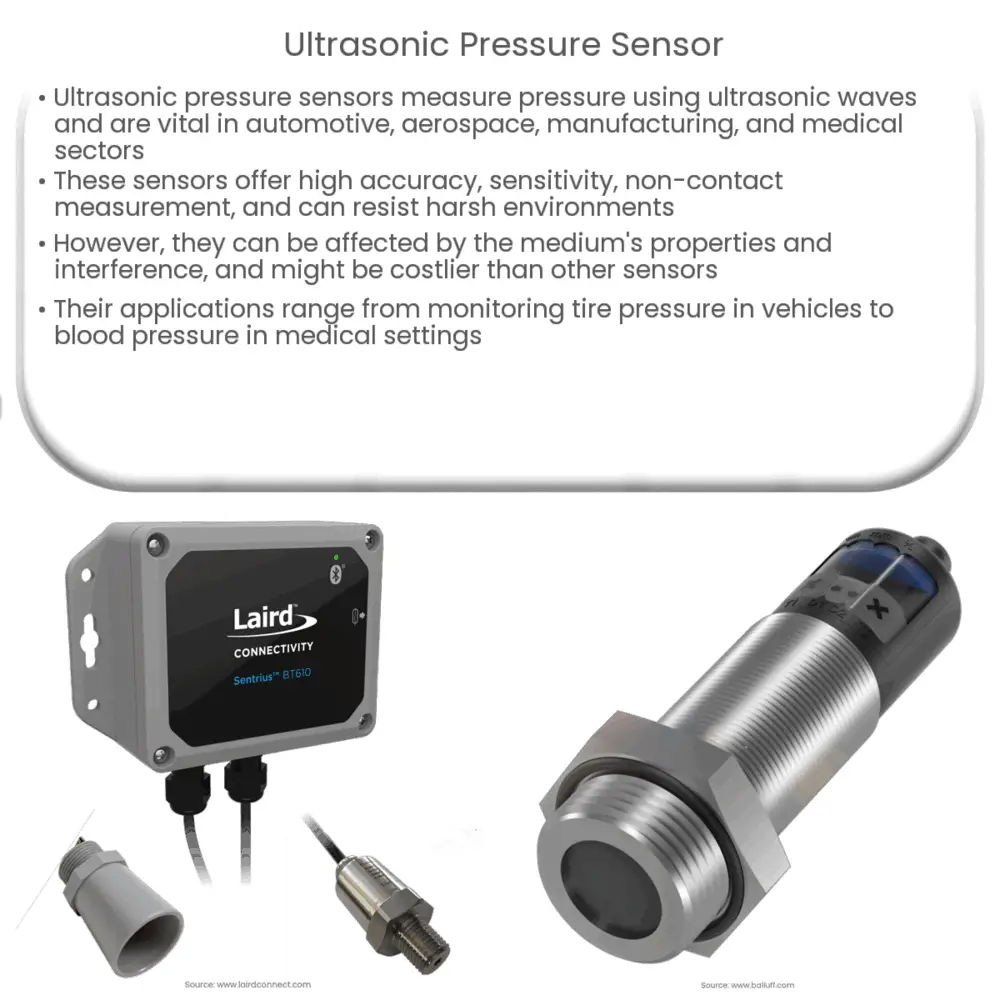Ultrasonic pressure sensors measure pressure using high-frequency sound waves, offering accuracy, sensitivity, and durability in various industries.

Ultrasonic Pressure Sensors: A Comprehensive Overview
Introduction
In today’s rapidly evolving technological landscape, precise and efficient measurement of pressure is crucial for a wide range of industries, including automotive, aerospace, manufacturing, and medical. Ultrasonic pressure sensors have emerged as an effective and reliable solution for these needs, offering superior accuracy, sensitivity, and durability. In this article, we will explore the fundamentals of ultrasonic pressure sensors, how they work, and their various applications.
What is an Ultrasonic Pressure Sensor?
An ultrasonic pressure sensor is a type of transducer that measures pressure by utilizing the properties of ultrasonic waves. Ultrasonic waves are high-frequency sound waves, typically above the range of human hearing (above 20 kHz). These sensors detect changes in pressure by measuring the time taken for an ultrasonic wave to travel between the sensor and a reflecting surface, which is affected by the pressure in the medium.
How Do Ultrasonic Pressure Sensors Work?
Ultrasonic pressure sensors typically consist of a piezoelectric transducer and a microcontroller. The piezoelectric transducer is responsible for generating and receiving ultrasonic waves. It does so by converting an electrical signal into mechanical vibrations and vice versa. The microcontroller processes the received signal and calculates the pressure based on the time taken for the ultrasonic wave to travel to the reflecting surface and back.
There are two primary methods of measuring pressure using ultrasonic sensors: Time of Flight (ToF) and Phase Shift. In the ToF method, the sensor measures the time taken for the ultrasonic wave to travel from the transducer to the reflecting surface and back. This time is directly proportional to the distance between the sensor and the reflecting surface, which is affected by the pressure in the medium. In the Phase Shift method, the sensor measures the phase difference between the transmitted and received ultrasonic waves. This phase difference is related to the pressure in the medium, allowing for its calculation.
Advantages of Ultrasonic Pressure Sensors
Ultrasonic pressure sensors offer several advantages over other types of pressure sensors, including:
- Accuracy: These sensors provide high-resolution measurements, ensuring accurate pressure readings.
- Sensitivity: Due to their high-frequency nature, ultrasonic sensors can detect minute changes in pressure.
- Non-contact measurement: As the measurement is based on the propagation of ultrasonic waves, no physical contact is required between the sensor and the medium being measured, reducing the risk of contamination or damage.
- Resistance to harsh environments: Ultrasonic sensors can withstand high temperatures, humidity, and corrosive environments, making them suitable for a wide range of applications.
Disadvantages of Ultrasonic Pressure Sensors
Despite their many advantages, ultrasonic pressure sensors also have some limitations:
- Medium-dependent performance: The performance of these sensors may be affected by the properties of the medium being measured, such as its density, viscosity, or temperature. This may require additional calibration or compensation methods.
- Interference: Ultrasonic sensors can be affected by ambient noise or other ultrasonic sources, which may lead to inaccurate measurements. Proper shielding and filtering techniques can help minimize these effects.
- Cost: Ultrasonic pressure sensors can be more expensive than other types of sensors, such as capacitive or piezoresistive sensors, due to their complex design and manufacturing process.
Applications of Ultrasonic Pressure Sensors
Ultrasonic pressure sensors are used in a wide variety of industries and applications. Some of the most common ones include:
- Automotive: In vehicles, ultrasonic sensors help monitor tire pressure, fuel level, and fluid levels in various systems, improving safety and efficiency.
- Aerospace: These sensors are used to monitor cabin pressure, hydraulic systems, and fuel levels in aircraft, ensuring optimal performance and safety.
- Manufacturing: Ultrasonic sensors can be used to monitor pressure in pipes, tanks, and other vessels, helping to maintain safe and efficient operations.
- Medical: In medical applications, these sensors are employed to monitor blood pressure, intracranial pressure, and pressure in medical devices such as ventilators and infusion pumps.
- Environmental Monitoring: Ultrasonic pressure sensors can be used to measure water levels, atmospheric pressure, and other environmental parameters, aiding in research and early warning systems.
Conclusion
Ultrasonic pressure sensors are a versatile and powerful tool for measuring pressure in various applications. Their high accuracy, sensitivity, and durability make them an ideal choice for many industries. However, potential limitations, such as medium-dependent performance and susceptibility to interference, should be taken into account when selecting the appropriate sensor for a given application. By understanding the principles, advantages, and disadvantages of ultrasonic pressure sensors, engineers and technicians can make informed decisions when implementing them in their projects.

